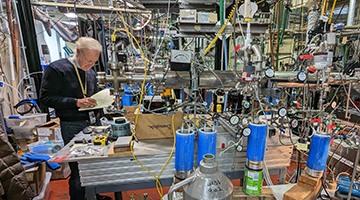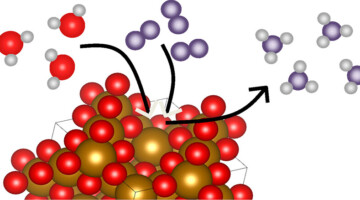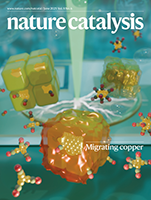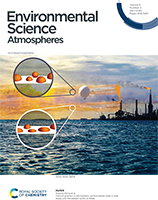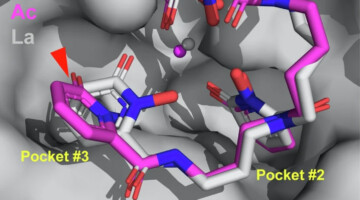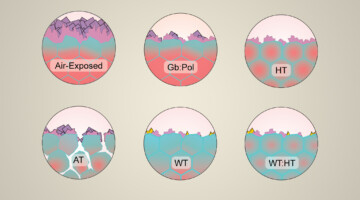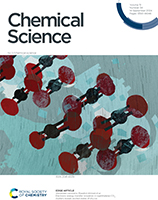A research team used the ALS to recreate how the Sun breaks apart nitrogen to inform a new model that can be used to understand the fate of a variety of elemental isotopes to explain atmospheric evolution on planets across the solar system. Read more »
From Magnetite to Ammonia, A New Line of Production
Ammonia is a critical ingredient in many important industrial and agricultural applications. The Haber–Bosch process is the primary process for large-scale ammonia production. A new study uses an experimental–theoretical approach to uncover how interfacial chemistry at the magnetite–water interface drives ammonia synthesis under ambient temperature and pressure. Read more »![]()
![]()
Operando probing dynamic migration of copper carbonyl during electrocatalytic CO2 reduction
In their work, Peidong Yang and colleagues reveal the dynamic evolution from faceted Cu nanocatalysts into metallic nanograins during CO2 reduction driven by the surface migration of electrogenerated copper carbonyl. Read more »
Efficient Upcycling of Plastic Waste into Useful Liquid Fuels
Researchers found a way to turn single-use plastics (e.g., grocery bags and packaging) into useful liquid fuels, like components of gasoline or diesel, without needing high heat, rare metals, or added chemicals. The work presents a promising pathway to address the global plastic waste crisis, with both environmental and economic advantages. Read more »
Polyethylene Upcycling to Liquid Alkanes in Molten Salts under Neat and External Hydrogen Source-Free Conditions
Researchers found a way to turn single-use plastics (e.g., grocery bags and packaging) into useful liquid fuels, like components of gasoline or diesel, without needing high heat, rare metals, or added chemicals. The work presents a promising pathway to address the global plastic waste crisis, with both environmental and economic advantages. Read more »
Vertical gradient in atmospheric particle phase state: a case study over the alaskan arctic oil fields
Integrating chemical composition and phase state measurements demonstrated that carbonaceous-rich and organic-dominated particles exhibited higher viscosities, while inorganic-rich particles displayed lower viscosities. This finding establishes an association between composition and phase state, offering critical insights into the vertical stratification of Arctic particles. Read more »
A Macromolecular Scaffold for Probing Actinium Chemistry
By encapsulating actinium atoms within a macromolecular complex for analysis using protein crystallography, researchers discovered that actinium has a unique solid-state bonding configuration. A better understanding of actinium behavior could help improve a promising cancer treatment known as targeted alpha therapy. Read more »![]()
![]()
Excited States in CO2 Clusters Shed Light on Astrochemical Formation Mechanisms
A vacuum ultraviolet photoionization study conducted at the ALS revealed a new mechanism between molecules that converts high-energy ultraviolet light into free electrons. The results provide insights into interactions between CO2 and organic molecules, which are crucial for understanding astrochemical interactions as well as green chemistry and renewable energy development. Read more »
Studying Interfacial Effects in Solid-Electrolyte Batteries
An ambient-pressure probe of a solid electrolyte revealed how surface electrochemical mechanisms lead to poor electrolyte performance and battery failure. The results can help scientists engineer better coatings and interfaces, which are essential for building safer and better-performing batteries, particularly for use in vehicles. Read more »![]()
![]()
Electronic energy transfer ionization in naphthalene–CO2 clusters reveals excited states of dry ice
The interaction between CO2 and polycyclic aromatic hydrocarbons is of interest in astrochemically relevant ices, the transition to renewable energy, and the development of green chemistry. We investigate the VUV excitation of the naphthalene–CO2 complex and observe excited states of CO2 through a newly identified electronic energy transfer ionization mechanism. Read more »
- 1
- 2
- 3
- …
- 13
- Next Page »
